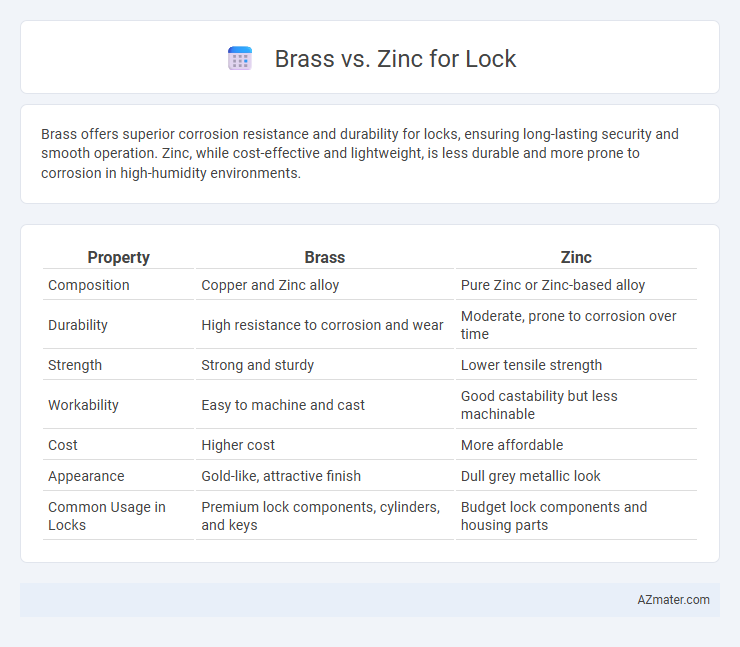Brass offers superior corrosion resistance and durability for locks, ensuring long-lasting security and smooth operation. Zinc, while cost-effective and lightweight, is less durable and more prone to corrosion in high-humidity environments.
Table of Comparison
| Property | Brass | Zinc |
|---|---|---|
| Composition | Copper and Zinc alloy | Pure Zinc or Zinc-based alloy |
| Durability | High resistance to corrosion and wear | Moderate, prone to corrosion over time |
| Strength | Strong and sturdy | Lower tensile strength |
| Workability | Easy to machine and cast | Good castability but less machinable |
| Cost | Higher cost | More affordable |
| Appearance | Gold-like, attractive finish | Dull grey metallic look |
| Common Usage in Locks | Premium lock components, cylinders, and keys | Budget lock components and housing parts |
Overview: Brass vs Zinc in Lock Manufacturing
Brass exhibits superior corrosion resistance and durability, making it a preferred material in high-quality lock manufacturing, especially for exterior applications exposed to harsh weather. Zinc offers cost-effectiveness and ease of die-casting, which allows for complex lock designs but tends to be less durable and prone to corrosion over time compared to brass. The choice between brass and zinc hinges on the desired balance between longevity, aesthetic appeal, and manufacturing expenses in lock production.
Material Composition of Brass and Zinc Locks
Brass locks are primarily composed of copper and zinc alloys, with copper content typically ranging from 60% to 70%, providing excellent corrosion resistance and durability. Zinc locks are usually made from zinc alloys that include aluminum, magnesium, and copper, designed for cost-effectiveness and moderate strength. The higher copper content in brass enhances its antimicrobial properties and wear resistance, making it preferable for high-security and long-lasting lock applications compared to zinc-based alternatives.
Durability and Strength Comparison
Brass locks demonstrate superior durability and corrosion resistance, making them ideal for long-term use in various environmental conditions. Zinc locks offer adequate strength but are more prone to wear and tear, especially in high-security applications. The inherent hardness of brass alloys provides enhanced resistance to physical impacts and tampering compared to zinc counterparts.
Corrosion Resistance: Brass vs Zinc Locks
Brass locks offer superior corrosion resistance due to their copper content, making them ideal for outdoor and marine environments where moisture exposure is high. Zinc locks, while more affordable, tend to corrode faster when exposed to harsh weather conditions, limiting their durability over time. This makes brass the preferred choice for long-lasting, rust-resistant lock applications.
Security Performance of Brass and Zinc
Brass locks offer superior security performance due to their higher durability, resistance to corrosion, and robustness against physical attacks, making them ideal for long-term use in high-security environments. Zinc locks, while more affordable and resistant to certain types of corrosion, tend to be softer and more susceptible to picking and forced entry. The inherent strength and wear resistance of brass ensure enhanced lock integrity and reliability compared to zinc counterparts.
Cost Analysis: Brass vs Zinc Locks
Brass locks typically cost more than zinc locks due to the higher price of raw brass material and its superior durability and corrosion resistance. Zinc locks offer a more budget-friendly option, often used in applications where cost savings are prioritized over long-term strength and aesthetic appeal. The choice between brass and zinc hinges on balancing initial investment against longevity and maintenance expenses.
Environmental Impact of Brass and Zinc
Brass locks, primarily made from copper and zinc, have a lower environmental impact due to their high recyclability and longer lifespan, reducing the need for frequent replacements. Zinc, while also recyclable, often involves more energy-intensive extraction and smelting processes, leading to higher carbon emissions. Choosing brass over zinc for locks contributes to sustainability by minimizing resource depletion and lowering greenhouse gas emissions during production.
Popular Applications in Lock Industry
Brass is widely favored in the lock industry for its corrosion resistance and durability, making it ideal for high-security locks, padlocks, and door handles exposed to outdoor environments. Zinc, valued for its cost-effectiveness and ease of casting, is commonly used in internal lock components and decorative lock parts where strength is less critical. The choice between brass and zinc hinges on balancing longevity and budget, with brass dominating premium applications and zinc preferred in mass-produced, budget-friendly locks.
Maintenance and Longevity
Brass locks exhibit superior resistance to corrosion and require minimal maintenance, making them ideal for long-term use in varying environmental conditions. Zinc locks, while more affordable, tend to oxidize and deteriorate faster, necessitating more frequent upkeep and eventual replacement. Choosing brass ensures enhanced durability and reduced maintenance efforts, resulting in longer-lasting lock performance.
Choosing the Right Lock Material: Brass or Zinc
Choosing the right lock material depends on durability, corrosion resistance, and cost efficiency. Brass locks offer superior corrosion resistance and longevity due to their natural antimicrobial properties, making them ideal for outdoor and high-humidity environments. Zinc locks provide a more affordable option with moderate corrosion resistance but may wear faster under heavy use, making brass the preferred choice for long-term reliability.

Infographic: Brass vs Zinc for Lock
 azmater.com
azmater.com